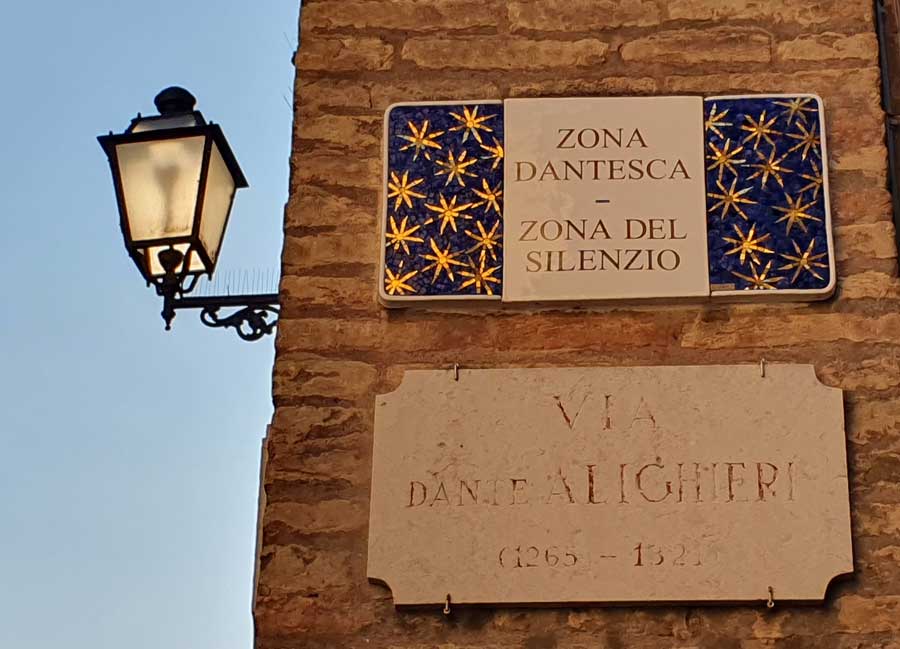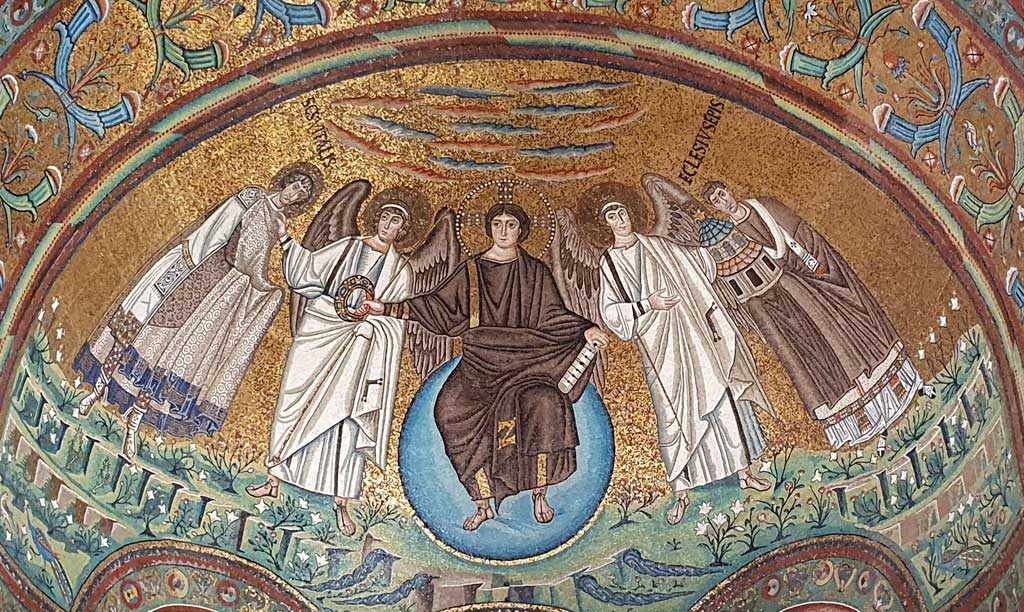About Ravenna
Ravenna is an elegant town in the Emilia-Romagna region of Italy, close to the Adriatic coast. As a destination it is a feast for Italy-lovers, still preserving the artistic light which shone through the so-called Dark Ages, when this city was one of the most important in the world.
Why visit Ravenna?
- Those breathtaking mosaics
- A fascinating and unique history
- Ideal for a mellow city-break with lots to see
- Emilia-Romagna cuisine
- In the footsteps of Dante
- And in the footsteps of Byron
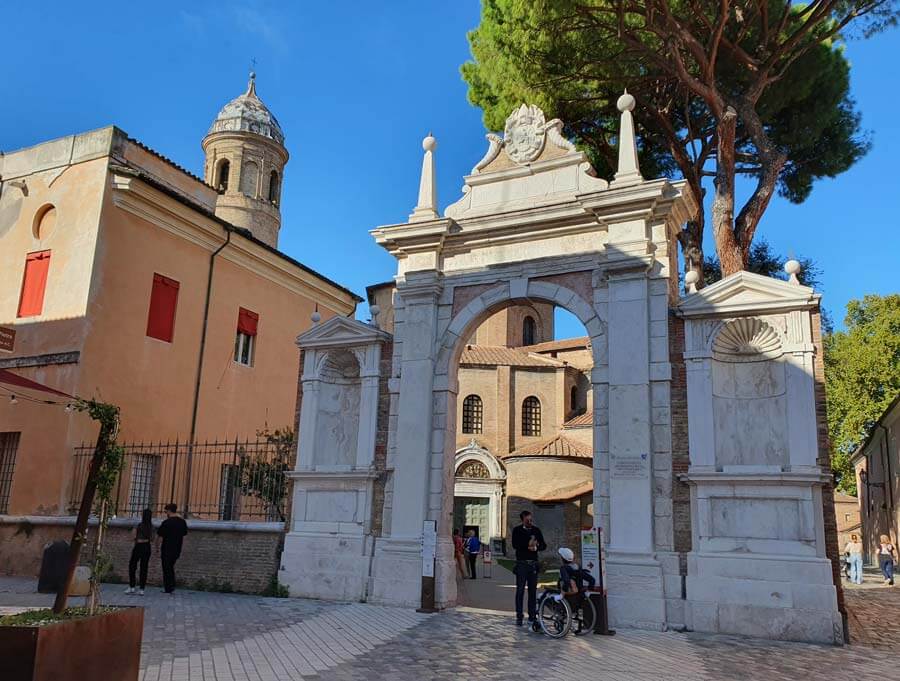
Ravenna is most famous for its fabulous early Christian and Byzantine mosaics and the religious buildings which house them, dating to the 5th and 6th centuries. Over the course of the break-up of the Roman Empire Ravenna became the capital of the Western Empire, then continued to thrive under Ostrogoth and Byzantine rule. The town’s greatest mosaics can still be admired in their original church settings, and the most important have been given UNESCO World Heritage status.
Nowadays Ravenna is no longer a seat of power. And while it is arty, it’s no longer the global hub of artistic interchange it once was. This unpretentious town is, though, an extremely pleasant place to visit, where you can wander, soak up history, admire art enjoy eat fine meals in Italy’s most foodie region.
Not one of Italy’s most obvious tourist destinations, Ravenna appeals principally to those who have a particular interest in history, culture and art , and those want to know the country in greater depth. This means that the streets are usually not over-crowded with tourists or souvenir stalls, and there is a real ‘local’ feel as residents bump around the town’s lanes on their bicycles, greeting friends and collecting the shopping. And the other visitors you see are likely to be motivated and independent travellers themselves, guidebook in hand and absorbed in history.
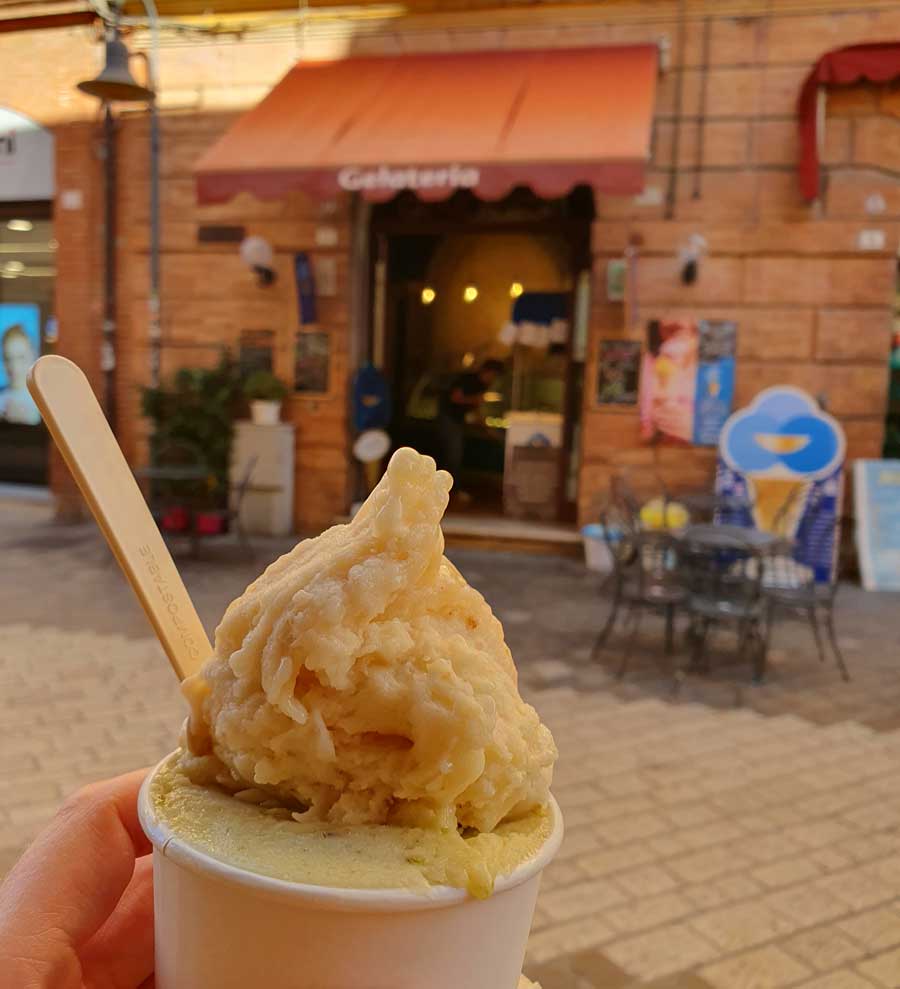
Planning your visit to Ravenna
If you are planning a visit to Ravenna, you will almost certainly end up with a long check-list of sights to visit. This is a destination where it pays off to spend a little time reading up and preparing in advance. You’ll find more detail to cover each subject further down this page, but here are some quick tips.
- How long to stay? In just a day you can see Ravenna’s highlights, but you will have to miss a number of really worthwhile sights. You can see and enjoy the best of Ravenna in a couple of days, making it an ideal destination for a short city break. Staying longer will give you more time to relax or explore the area further.
- City break or touring holiday? A two-centre holiday could combine Ravenna with regional capital Bologna or one of the sunny Adriatic beach resorts nearby. There are lots of good choices for a multi-stop tour of Emilia-Romagna.
- Get flights and travel sorted. Bologna is the most convenient international airport for Ravenna. Take the airport monorail shuttle to Bologna Centrale railway station. Cheap regional trains connect Bologna Centrale with Ravenna, taking between an hour and an hour and half.
- Ravenna has good-value accommodation options compared with other cities in the region, but not that many of them. So book ahead for the best choice. See my suggestions below, or head straight to an availability search: Ravenna hotels, B&Bs and apartments (Booking.com, my affiliate link)
- Background reading or learning on the spot? Ravenna and its inspired golden mosaics are even more fascinating with some historical context. I’d suggest reading some history in advance or taking a trip out to the village of Classe at an early point in your stay to visit an excellent modern museum which gives a fine overview of Ravenna’s past (more below).
- Read more about things to see and do (further down this page), note your priorities and start to make a rough daily itinerary, bearing in mind opening times. Most of Ravenna’s sights don’t take long to see, but as there are a lot of them dotted around the town centre, it is helpful to have a plan and tick them off one by one. Check websites for the latest on access and whether you need to book time slots anywhere.
- At the time of writing there’s a somewhat confusing range of combined entrance tickets. To help keep costs down, run through the to-see list you’ve compiled, and figure out what works best for you.
- Again, although there are good places to eat and drink in Ravenna, they’re not that obvious or numerous in the city centre, so consider booking in advance for evening meals. My recommendations are below.
Where to stay in Ravenna
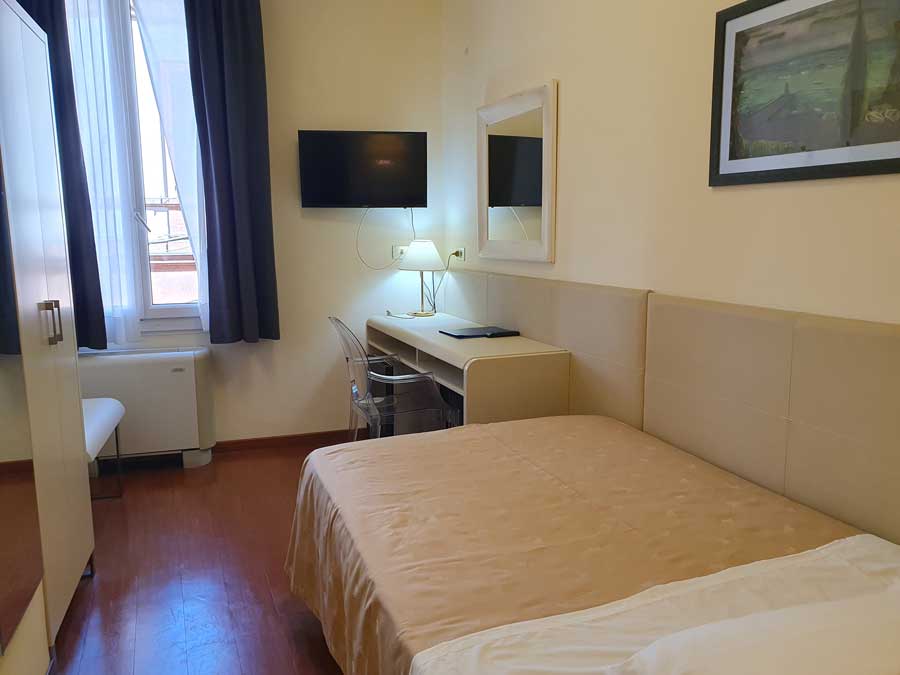
I’ve stayed twice at the convenient and good-value Hotel Centrale Byron. You couldn’t be in a more central spot for seeing the sights on foot. The hotel may feel a bit dated, and the wi-fi wasn’t good on my last stay, but otherwise it had everything I needed including friendly staff, and the location is ideal.
> Hotel Centrale Byron – a very good-value three-star hotel with comfortable rooms; efficient and friendly. Not the top choice for a luxurious or romantic stay, but practical for sightseeing.
> Albergo Cappello – on a previous visit I spent more money for the special experience of spending a night in a historic palazzo with elegant rooms and suites, and frescoes on the walls. Admittedly, this was years ago but I still remember the luxurious bedlinen.
> More Ravenna hotels, B&Bs and holiday apartments
The accommodation links on this page are my affiliate links and will help support this website without you paying more.
Ravenna tourist attractions
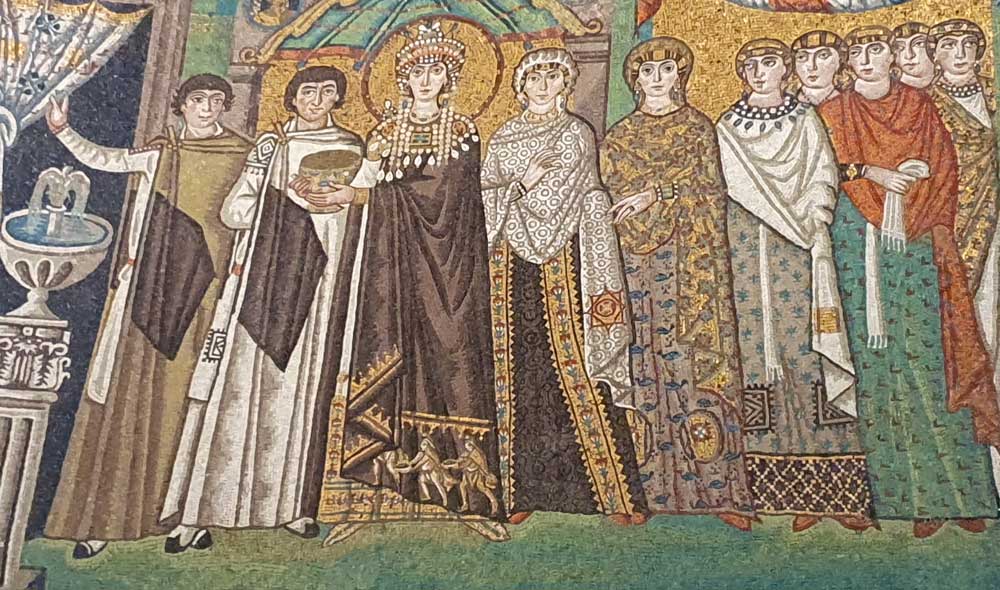
The heart of Ravenna, and the best place to get your bearings, is Piazza del Popolo, which can be reached in ten minutes from the railway station by walking straight ahead along Viale Farini and then Via Diaz. This charming piazza is lined with attractive historic buildings including the Palazzo Comunale (Town Hall), originally built in the fifteenth century. As they did elsewhere, the Venetians erected two columns in the square during their rule; instead of Venetian emblems these now are topped with statues of Ravenna’s patron saints San Vitale (St. Vitalis) and Sant’Apollinare (St. Apollonaris). There are cafés with outdoor tables, and it’s a lovely place to sit and relax.
The most important tourist attractions in Ravenna are the 1500-year-old mosaics, and the churches housing them, eight of which are on UNESCO’s World Heritage listing Early Christian Monuments of Ravenna. These first five listed below can be visited on a combined ticket and are open all day, seven days a week. Tickets can be bought online or at ticket offices near the churches; you may need to select a time slot for the two smallest buildings, the Mausoleo di Galla Placidia and the Battistero Neoniano. Info and tickets: https://www.ravennamosaici.it/. The ticket offices double as shops and have some classy mosaic and Dante-themed souvenirs.
Other sights have individual entrance fees; some participate in combined tickets.
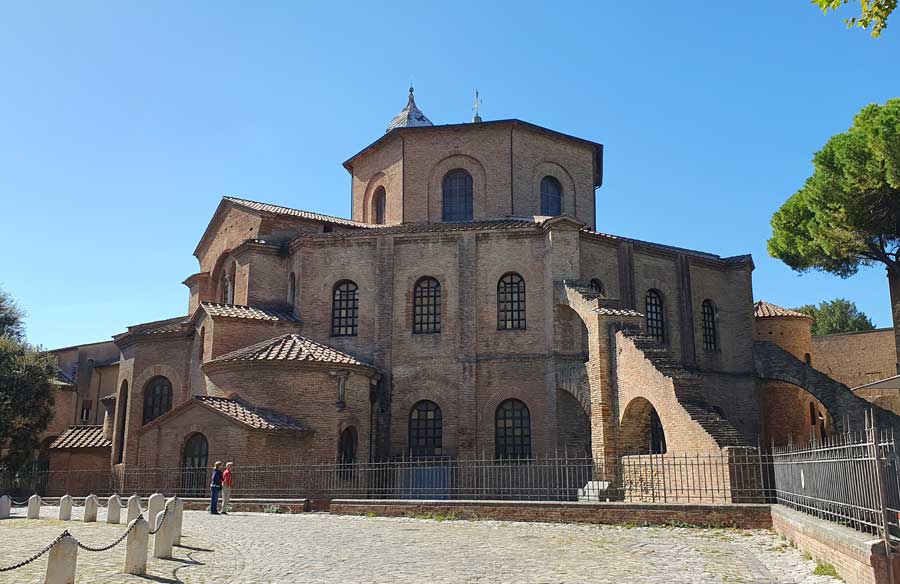
Basilica di San Vitale – This church is the glory of Ravenna and in UNESCO’s words “one of the highest creations of Byzantine architecture in Italy”. Built between 526 and 547 AD the building has a plain brick exterior, but the lofty and breathtaking interior is rich with marbles and mosaics. Byzantine mosaics high on walls and ceiling illustrate scenes from the Old Testament and include famous and beautiful representations of the Emperor Justinian, the Empress Theodora and their elegant retinues. Note that the ticket office for the basilica and mausoleum complex is a few yards away on Via Giuliano Argentario.
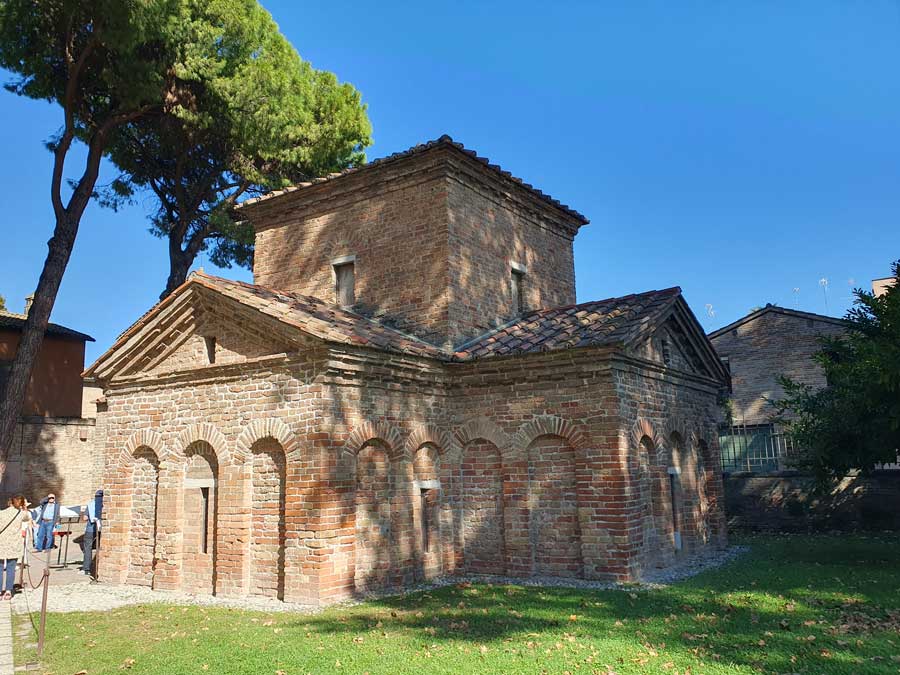
Mausoleo di Galla Placidia (Mausoleum of Galla Placidia) – Alongside San Vitale and visited at the same time, this is one of Ravenna’s most magical and memorable experiences. The mausoleum is a surprisingly tiny building: try to get inside when there is no tour group. Galla Placidia was an important woman: born in around 390 AD, she was the daughter, sister, wife and mother of Roman emperors and had a full and colourful life. This building is said to have been built as her tomb. However she died in Rome, and her body may never have been brought here. The ceiling is a blue field of little gold stars, with a cross in the centre and symbols of the Evangelists at each corner. Pictorial mosaics on the walls include a lovely one of the Good Shepherd.
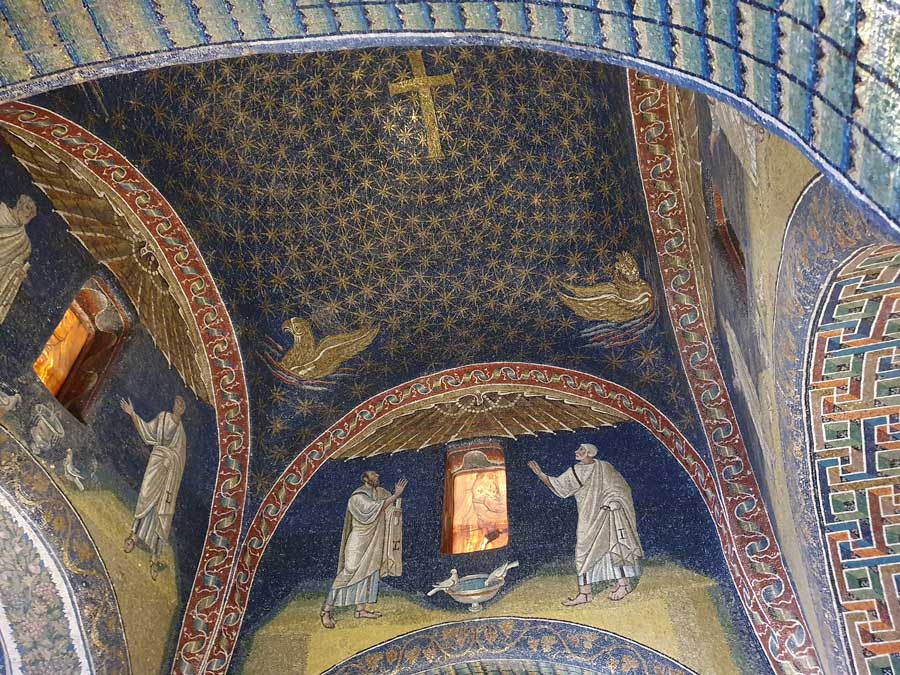
Battistero Neoniano – This baptistery was built at the beginning of the fifth century AD and was renovated by a bishop called Neone fifty years later (hence the name). The building is octagonal and its interior is highly decorated with marbles, carvings and mosaics as well as a large baptismal font. The mosaic in the domed ceiling portrays the story of the baptism of a young, fair-haired and nude Christ by John the Baptist.
Museo Arcivescovile and Cappella di Sant’Andrea – The Battistero Neoniano is alongside the Duomo, Ravenna’s cathedral (worth visiting), and behind the Duomo is the archbishop’s palace. Within the museum inside is the Cappella di Sant’Andrea, a little chapel on an upper floor dedicated to St Andrew that was the private oratory of the bishops. With mosaics covering the vaulted ceiling, this is like walking into a treasure chest. Among the images are a heroic warrior Christ, and mosaic roundels of apostles, saints and martyrs, including women. While there’s not much variation in the female portraits, some of the male faces are given significant individuality of expression and hairstyle.
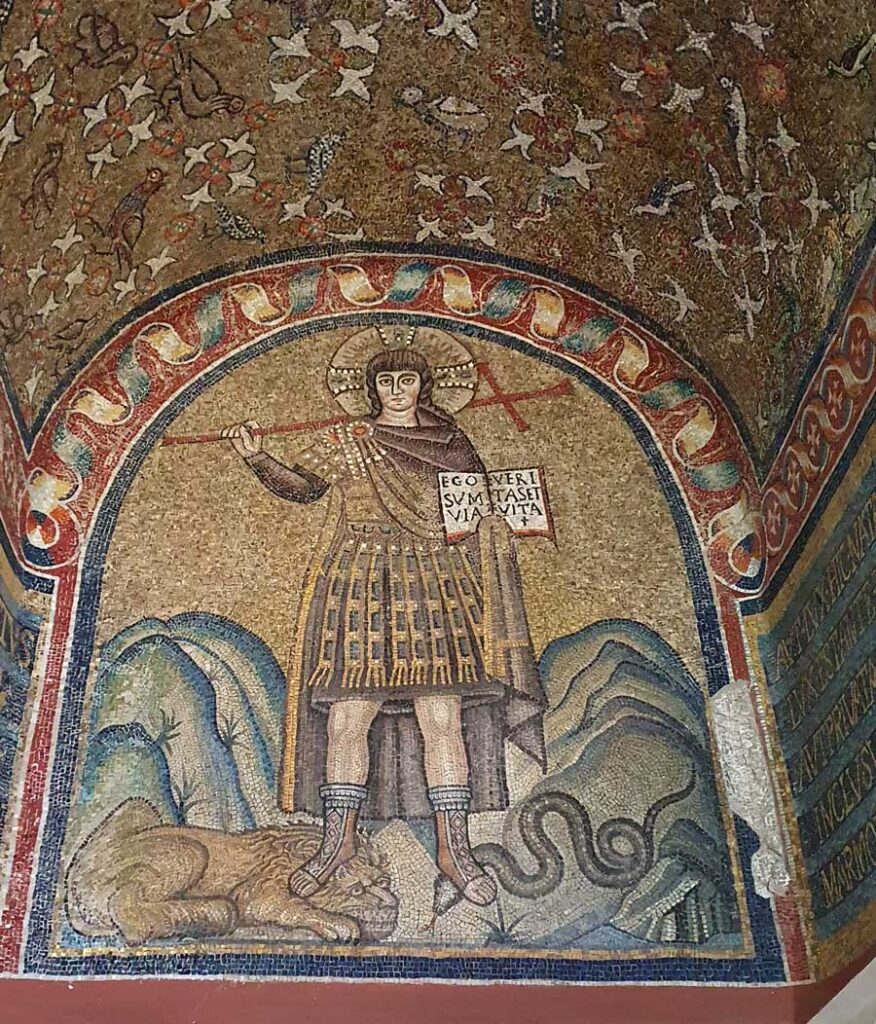
There are other treasures in the museum, too. These include the headless porphryry statue of a Roman emperor, and mosaic fragments which are a fascinating way to study close-up how faces and expressions were created in tesserae by the artist-craftsmen. The highlight, though, is the precious ivory throne or pulpit of Archbishop Maximian, thought to have been created in Constantinople and brought to Ravenna around 550 AD. A wood frame is faced with 27 surviving ivory panels delicately carved with Biblical scenes and plant decorations.
Basilica di Sant’Apollinare Nuovo – A short walk east from the heart of town, this basilica houses some of the most reproduced of Ravenna’s mosaics. A mosaic frieze shows processions of martyrs and virgins leaving Ravenna – represented by the palace of Theoderic, helpfully labelled PALATIUM – and the port of Classe to pay tribute to Christ and the Madonna. In addition to being impressive, the mosaics give a vivid impression of 6th-century Ravenna and Classe.
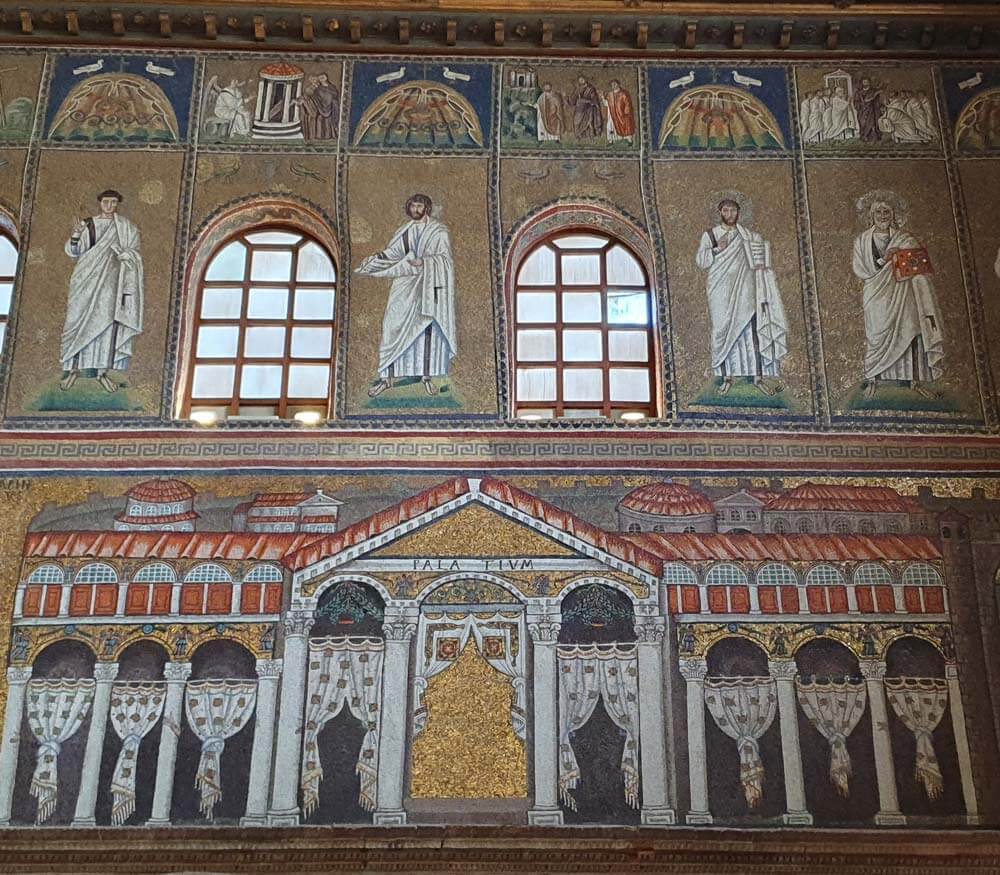
Mausoleo di Teodorico – The Mausoleum of Theoderic, or Theodoric, is also listed by UNESCO and can be visited on a combined ticket with the Museo Nazionale and the Basilica di Sant’Apollinare in Classe, which is outside Ravenna and which is described below. On both my visits I’ve found this one of the most memorable and striking sights of Ravenna. Something about the setting and the survival of this building gives the visitor a real feeling of being connected to history.
The mausoleum, a bold white cylindrical building, was built outside the city walls, so is some way from the other tourist sights of Ravenna – it’s walkable, but allow time. Theoderic, known as ‘the Great’, was the King of the Ostrogoths and became ruler of Italy, with his capital here in Ravenna. His tomb, constructed around 520 AD, is topped with a single, massive block of stone. Visitors can enter the building and climb to the upper floor.
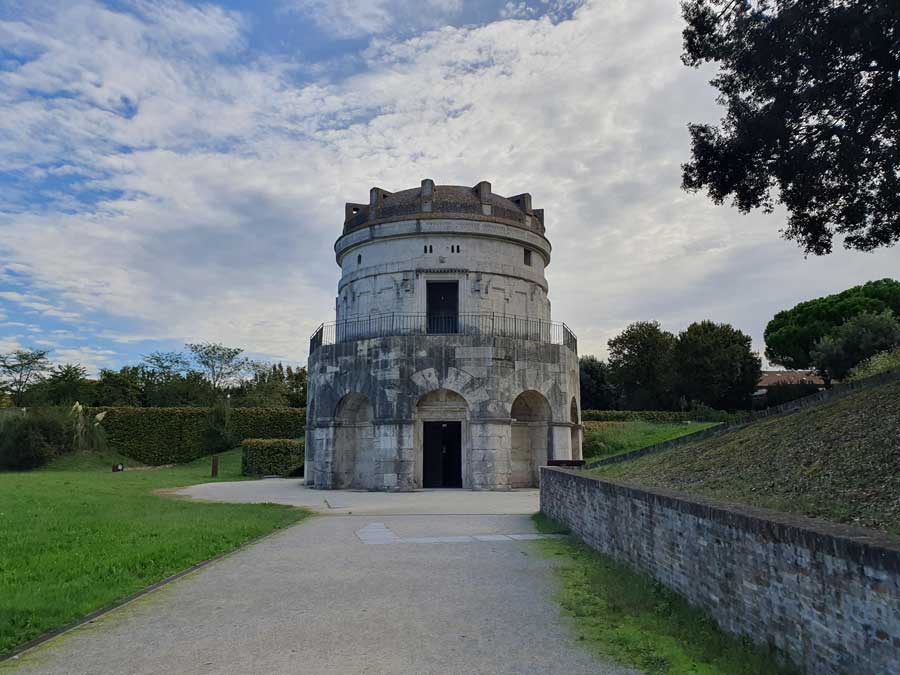
Battistero degli Ariani (Arian Baptistery) – This small baptistery (£, ticket machine by door) is crowned by another lovely mosaic depicting the baptism of Christ, with the inclusion of a personification of the River Jordan. The Apostles are portrayed circling the scene. The iconography, including a young, beardless, naked Christ, belongs to the Arian Christian beliefs brought by the Goths when they were in power in Ravenna. It was Theoderic who commissioned the Arian Cathedral in Ravenna (mostly rebuilt and now the church of the Holy Spirit) and this baptistery alongside at the end of the 5th century.
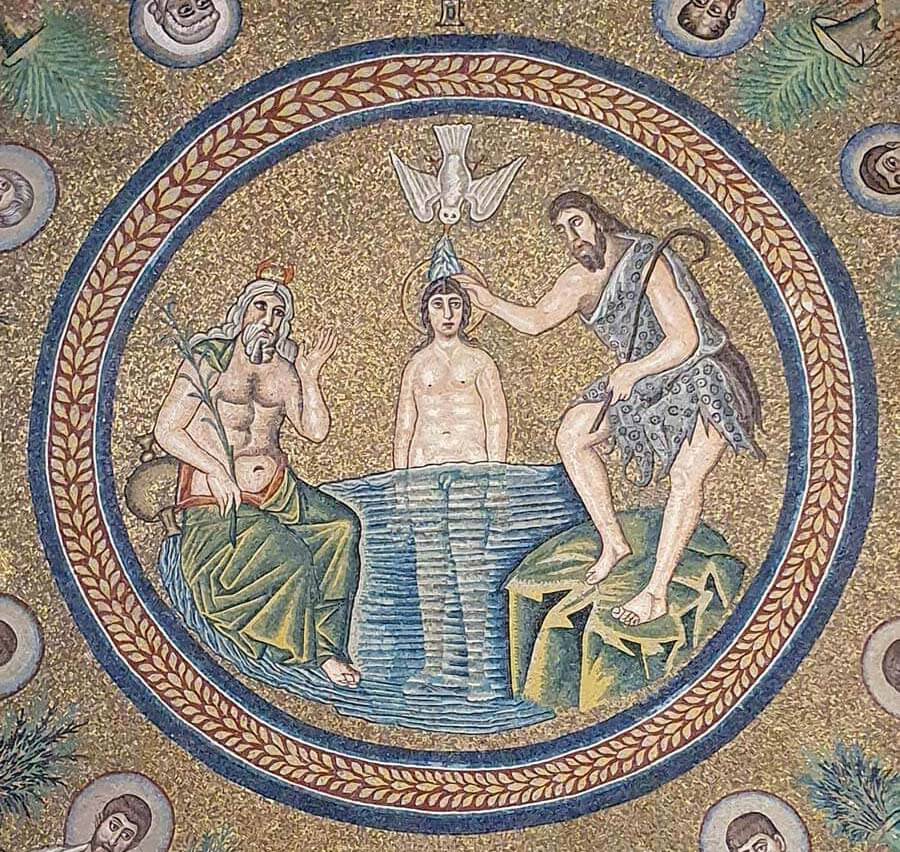
San Francesco – The church of San Francesco offers another of Ravenna’s most memorable sights: a flooded crypt where goldfish swim over a mosaic shimmering beneath them. This atmospheric scene can be viewed through a window inside the church, beneath the main altar – take a coin for the illumination. With inscriptions in Greek and Latin, the mosaics are 5th-century, and made me think of Prospero drowning his books.
The church itself has been much rebuilt, but contains some interesting decoration including the impressive sarcophagus of Ostasio da Polenta in red Verona marble and white marble. The altar itself is an elaborate a 5th-century sarcophagus.
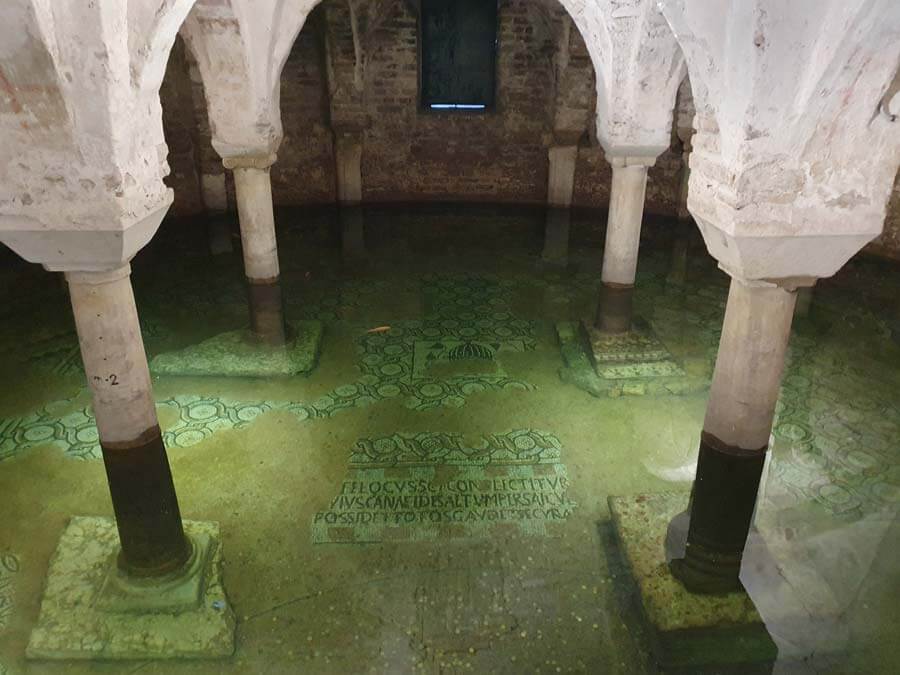
Around the corner from San Francesco is Dante’s tomb (more below on the poet). Between the two is an enclosure containing more tombs, and a small ivy-covered mound with a plaque recording that the poet’s remains were placed here for safekeeping during WW2.
Museo Nazionale di Ravenna (National Museum) – This archaeology and history museum is in the old monastic complex alongside San Vitale and the Mausoleum of Galla Placidia, although it is entered on a different ticket (combined tickets with select other sights available). The museum is large, rambling and varied, with inconsistent labelling and a confusing layout, but it is worth visiting and persevering as there are some interesting and high-quality exhibits.
The contents of the museum range from the interior of a historic pharmacy to a section on the prehistoric era. There is some attractive inlaid furniture including a fantastic sixteenth-century cherry-wood cabinet decorated with imaginary towns, hunting scenes and fair ladies. One of the most interesting exhibits is a small section of mosaic from San Vitale, showing the head of an angel. As with the fragments in the Palazzo Arcivescovile, being able to examine this at close quarters provides a real insight into the techniques and skills employed to create the mosaics of Ravenna.
Domus dei Tappeti di Pietri – The ‘House of Stone Carpets’ is a collection of floor mosaics still mostly laid out where they were excavated among the ruins of ancient buildings dating from the various periods up until the 6th centuryAD. This archaeological site adds an extra dimension to a visitor’s picture of Ravenna through the centuries, on a more domestic level to the places of worship which are so well preserved. Entrance (ticketed) is through the church of Sant’Eufemia, and the visitor descends into a long underground space.
Not all the mosaics found here are still in-situ; an important mosaic of the Good Shepherd is now in the museum in Classe; a copy is kept here. Most of the remaining floors are geometric designs, but a fancy exception is a scene called the Dance of the Four Seasons, the original of which is now displayed on the wall. Figures representing the seasons (Summer is damaged and incomplete) dance together, accompanied by a musician playing pipes. It’s a vivid window into the Ravenna of the late ancient era. https://domusdeitappetidipietra.it/
MAR – Ravenna’s art museum hosts temporary exhibitions as well as containing a large permanent collection with art and exhibits from ancient to contemporary times. One of the museum’s highlights is the marble effigy of a knight, Guidarello Guidarelli, sculpted by Tullio Lombardo. https://mar.ra.it/
Rocca Brancaleone – Ravenna’s old fortress, which you’ll probably pass if walking to the Mausoleo di Teodorico, now has a little park inside its walls, with a café and children’s play area. Over the gateway of an inner keep is the winged Venetian lion. This fortress was built by the Venetians after they annexed Ravenna in 1441.
Biblioteca Classense – This important library is housed in a 16th-century ex-monastery around cloisters. It’s used by students and has some interesting spaces to explore (though I didn’t see any other tourists doing so). One of the most dramatic sights is the Sala del Mosaico, on the first floor on the street side of the building, where you’ll find a large mosaic with decorative designs and a central panel featuring a peacock. Originally excavated in Classe in the 19th century, the mosaic was taken apart, transported here and reassembled. The Sala Dantesca, once the refectory of the monastery, is grandly decorated with a large painting of the Wedding at Cana by Luca Longhi ,and a frescoed ceiling by his workshop.
There is a lot to see as you walk around Ravenna. I was particularly taken by the mosaic street signs and also small mosaics of flowers on walls, which are part of a project celebrating Ravenna as a “woman-friendly city”.
Byron in Ravenna
George Gordon Byron, Lord Byron, the famed English poet, spent time in Ravenna between 1819 and 1821, and this is one of several places in Italy he is remembered with affection and pride. Byron was here in attendance on his married lover, the young Teresa Gamba, Countess Giuccioli, with whom he contemplated settling down in marriage – should both their spouses die. Here he worked productively on his poems, wrote letters, went riding, got mixed up in political conspiracies, and kept a journal: “Clock strikes – going out to make love. Somewhat perilous, but not disagreeable.”
There is now a museum in Ravenna dedicated to the poet at Palazzo Giuccioli: Museo Byron (closed Mondays). In the same building (combined ticket) is a museum of Italy’s Risorgimento, the struggle towards national unity.
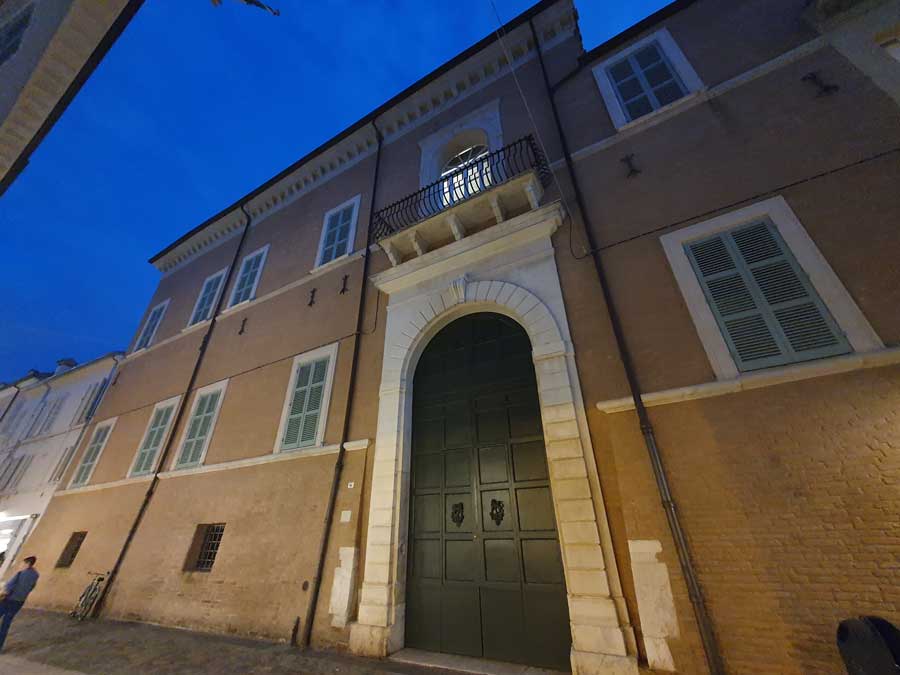
Dante in Ravenna
Italy’s most famous poet, Dante Alighieri, was exiled from his hometown Florence, and lived in Ravenna for the last three years of his life. He finished writing the Divine Comedy in Ravenna, and was buried here after his death in 1321. Dante’s tomb (Tomba di Dante), next to San Francesco, is a pilgrimage destination as much as a tourist attraction. In this little eighteenth-century chapel is a bas-relief of Dante by Pietro Lombardo and a light kept burning with oil donated by his birthplace, the city of Florence. There are museums dedicated to Italy’s ‘Supreme Poet’ as well: Museo Dante and Casa Dante, both close to the tomb. More about the Dante sights: https://vivadante.it/
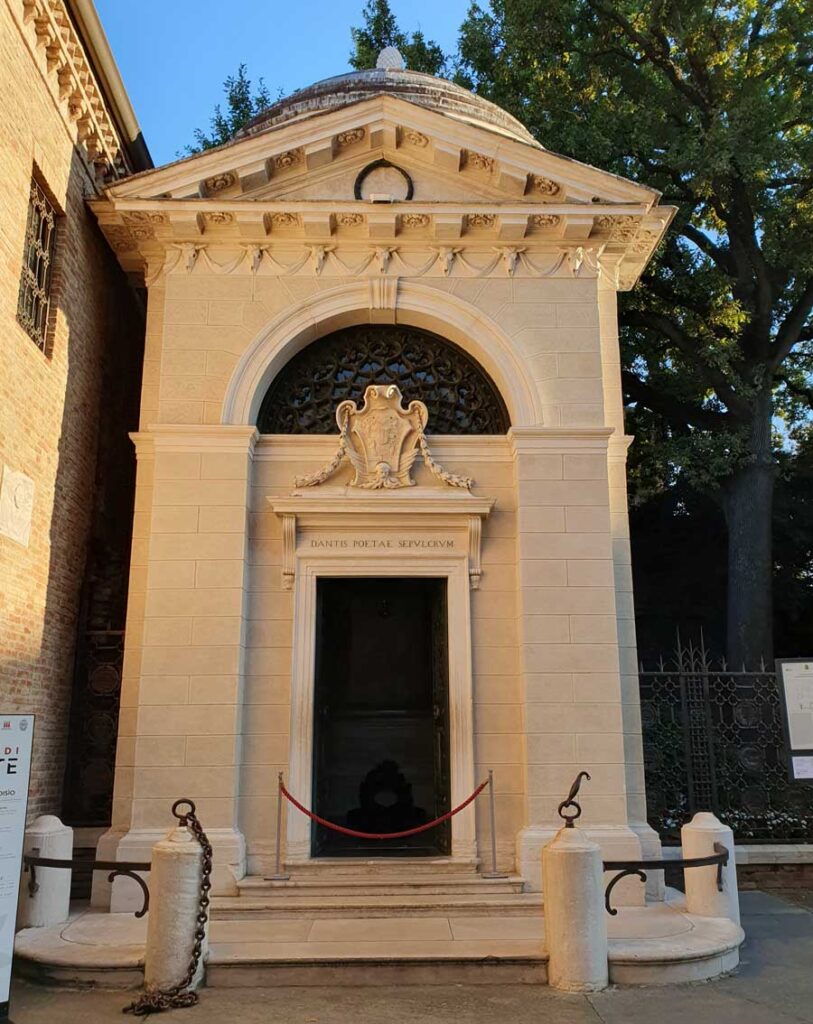
While it is an earlier period of history that brings most of Ravenna’s overseas visitors, Dante is much celebrated in the town and you’ll see his name and famous stern profile featured in names and street art around the centre and lots of Dante-themed events. One of the quirkier charms of Ravenna is the never-ending reading of the Divine Comedy. Every day at 5pm (winter) or 6pm (summer) a volunteer reads a canto from the poem in front of the poet’s tomb. If you want to take part, apply in advance via the Viva Dante website above (what a great thing to do on a holiday!). You can also follow online: https://www.facebook.com/RavennaperDante
Visiting Classe: Sant’Apollinare in Classe & Museo Classis Ravenna
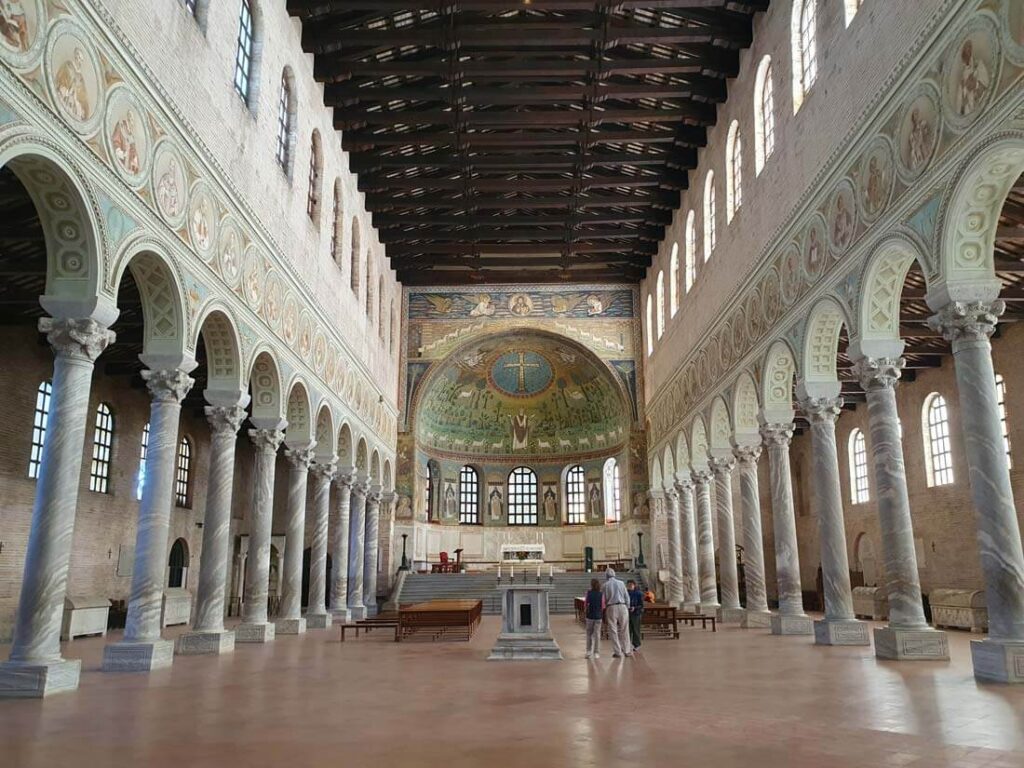
If you are in the area for history and mosaics, I’d recommend a trip out of central Ravenna to Classe, a village a fifteen-minute bus ride away. Here you can visit the atmospheric basilica of Sant’Apollinare in Classe (included in the UNESCO listing) and an excellent modern archaeological museum, the Museo Classis Ravenna.
Bus 4 from Ravenna station stops on Via Carducci between the station and the centre of Ravenna (Google Maps is helpful with planning). The bus ride takes around 20 minutes, and you can see the basilica across flat green fields on the left as the bus approaches; the stop is just afterwards (ask the driver). There is also a tiny railway station in Classe, and the train journey is only a few minutes to Ravenna, but trains are few, so plan around timetables. If you are driving towards the coast or seaside resorts from Rimini, Classe makes an easy stop on your itinerary.
The basilica dates to the early sixth century, and its round campanile (belltower) to the tenth century. The mosaics inside are among the finest in Ravenna. They show the transfiguration of Christ and St. Apollonaris with a flock of sheep and a charming landscape of flowers, trees and birds.
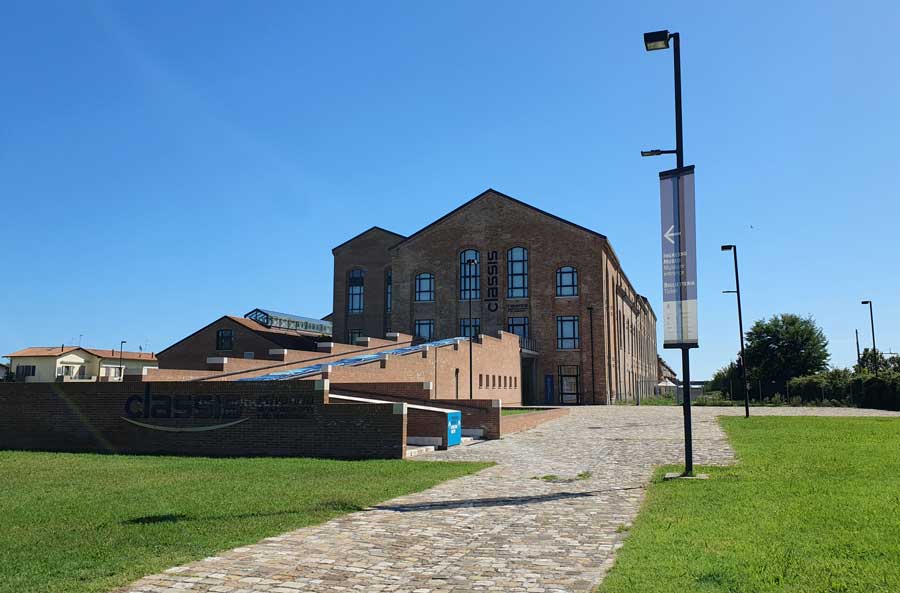
A few minutes walk from the basilica, the Museo Classis Ravenna is a ‘Museum of the City and Territory’ (https://classisravenna.it/). Housed in a restored and repurposed sugar beet refinery, it is fairly new and there were galleries yet to open when I visited. This is the best place to get a really good overview of Ravenna’s history beyond the famous mosaics. Classe was the main port of Roman Ravenna (as you can see in the mosaics in Sant’Apollinare Nuovo back in the town) and the museum tells the story of the area of Ravenna and Classe, its changing geography and urban development, and the lives of the people who lived here.
I found this an exemplary modern museum and very welcoming (it’s even got nice toilets). I highly recommend visiting if you’re interested in history and can allow the time. The museum route follows a timeline with good explanations – neither too detailed nor too brief – and has English translations. Through artefacts, exhibits, videos and animations you get a thorough introduction to the ancient city across the centuries. A few of the objects on display are copies, but most are original.
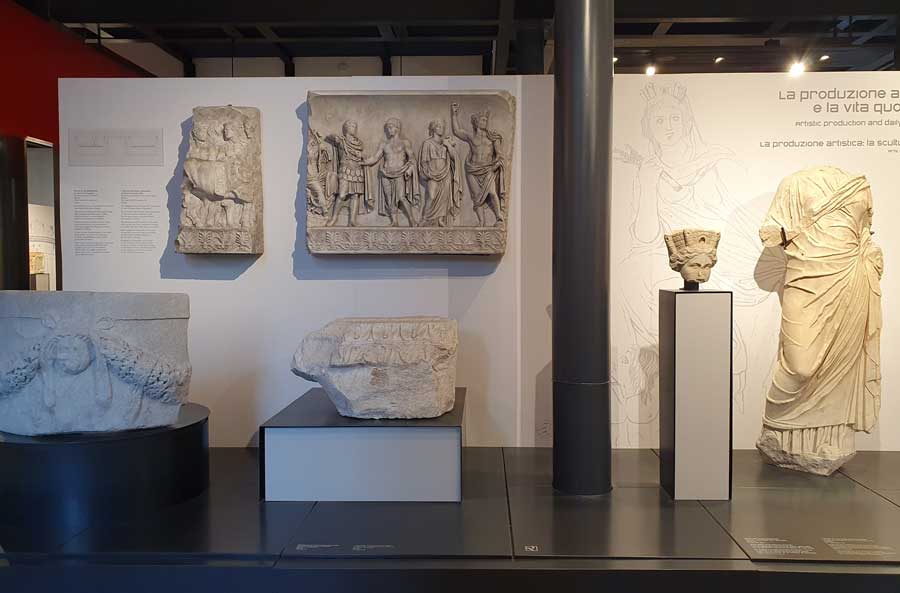
In a section titled Living and Praying is a fabulous room of mosaics, an amazing place to have to oneself, as I did. Highlights include the Good Shepherd mosaic from the Domus dei Tappeti di Pietra, which may or may not be Christian in its iconography, and a large mosaic with delightful cartoon-type figures of men and women.
Over the road from the museum, alongside the railway, is a little railway heritage area with a locomotive on display. And just past this is a park where you can find a children’s play area, benches and an excellent piadineria called Gli Azdori with a good choice of filled piadine and crescioni for lunch, including a vegan option I enjoyed with hummus, seasonal vegetables and sun-dried tomatoes. Operated from small marquee and a cabin kitchen, this is a very practical place to enjoy a quick lunch on the go while you’re sightseeing (closed Tues). There’s a drinking water tap at the station nearby.
Food and drink in Ravenna
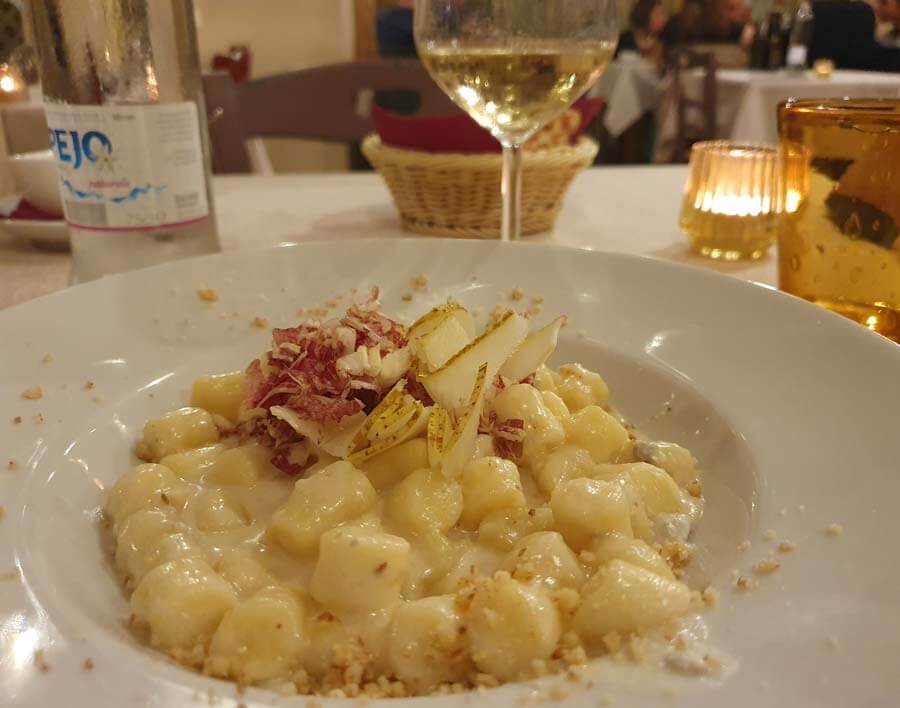
I enjoyed a delicious, traditional and filling meal at Trattoria La Rustica: a vegetable parcel with local fossa cheese fonduta followed by gnocchetti with gorgonzola and pear, along with excellent local-style flatbread and wine. With moderate prices and a cosy interior, it’s a popular choice so I’d recommend booking ahead.
For a slightly lighter meal in a less traditional environment, I headed to Passo Carraio Biobistrot, which offers modern vegetarian and vegan dishes on its menu along with cocktails and smaller dishes.
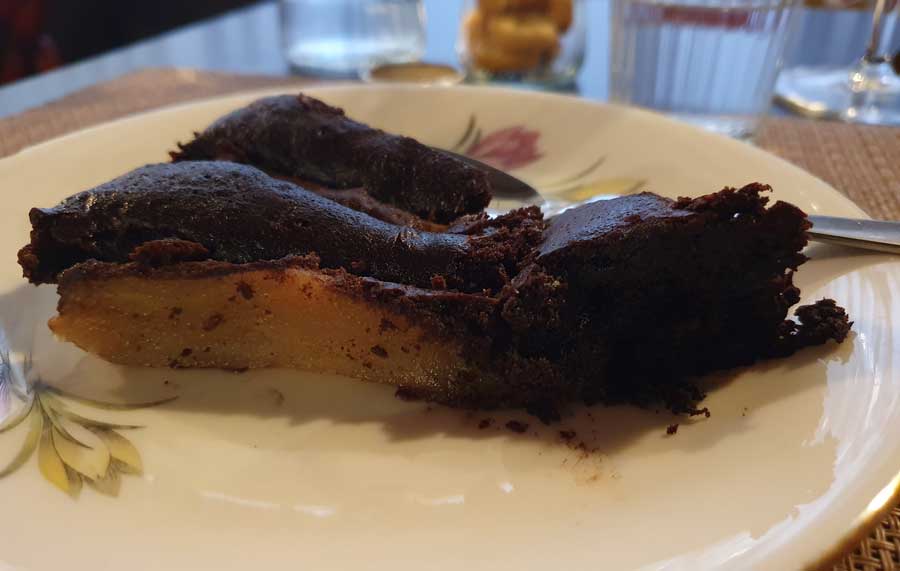
There aren’t actually that many obvious places to eat around the centre of Ravenna, so it’s worth noting any promising restaurants you spot during the day, or asking your hotel for recommendations, and booking ahead.
For a light, cheap lunch on the go when you’re sightseeing, you’ll find cafés, bars and takeaways around the town offering pizza slices, filled rolls and local piadine (heated, filled flatbread sandwiches) and crescioni (stuffed and rolled flatbread). During a busy day I found Gli Azdori in Classe (described above) a useful and tasty pitstop.
Ravenna has, like most Italian destinations, a choice of places to buy gelato. Gelati Allegri, in the heart of town on Via IV Novembre, has a good range of fresh seasonal flavours made with local products.
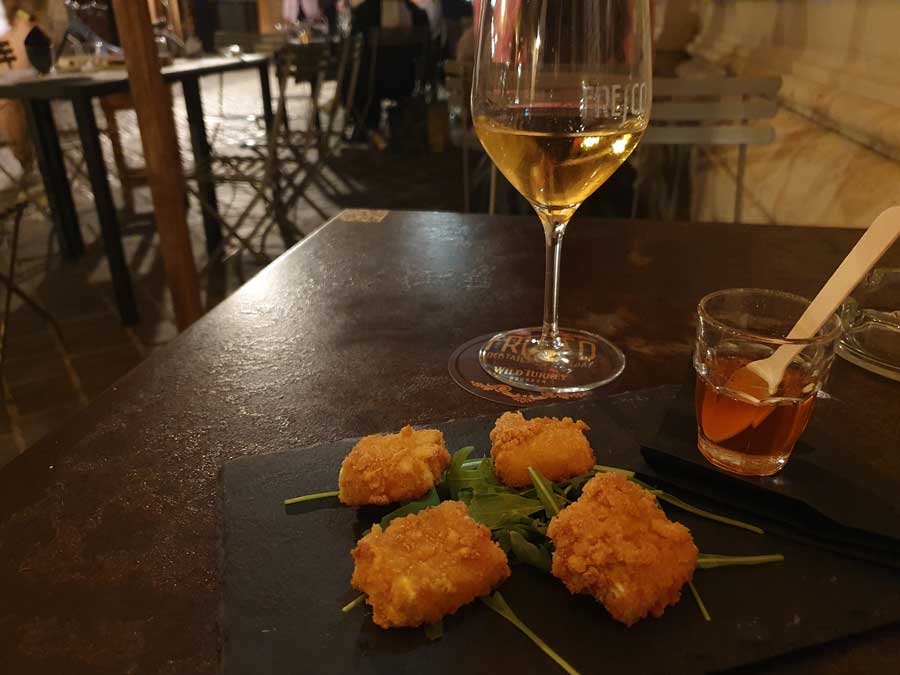
Naturally, Ravenna offers good opportunities for enjoying aperitivi combined with people-watching. The central bar Fresco has prime outdoor tables and serves wine, cocktails, nibbles and tapas. I enjoyed a glass of Trebbiano from Brisighella and Brie in breadcrumbs with honey.
Ravenna’s renovated Mercato Coperto on Piazza Andrea Costa, a historic market building, now houses a restaurant, small food businesses and a small supermarket. It’s a useful destination whether you’re looking for a meal, fresh bread, local cheeses or other speciality products to take home.
Events and things to do
Ravenna has quite a lively scene with special events and concerts; you can find listings at the tourist information office or on the helpful tourism website: https://www.turismo.ra.it/en. The summer is the best time to visit for outdoor entertainments and special concerts: the town hosts the Ravenna Festival with musical, theatrical and dance events, and there are also special tours organised to see the mosaics by night.
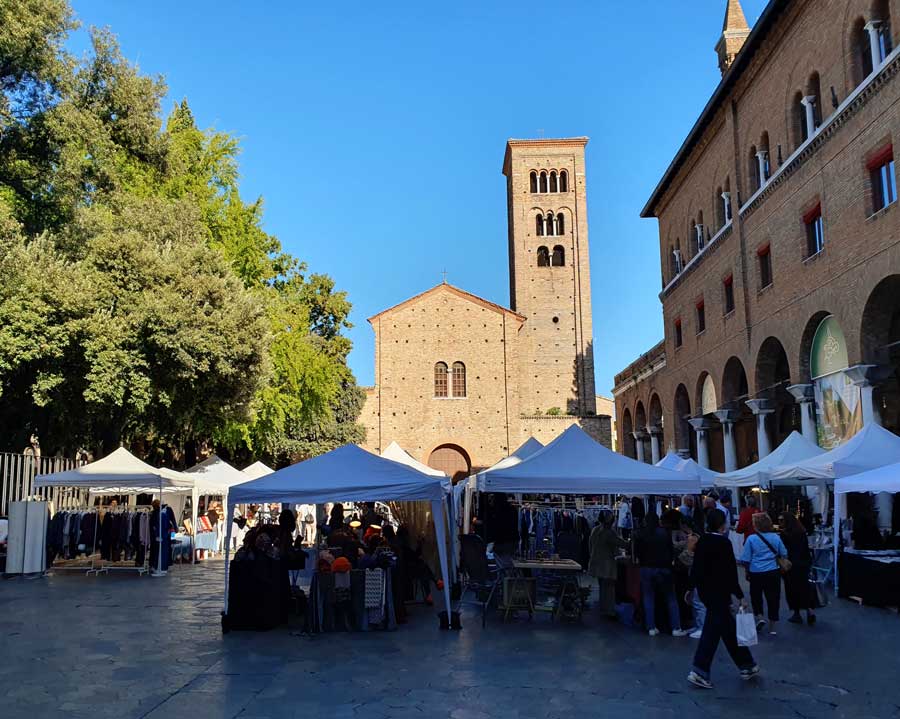
If you are on holiday with children, you may be interested in Mirabilandia, Italy’s largest theme park, which is a few miles from Ravenna. There is a bus service from Ravenna.
For the active, there are cycle tracks leading to the Mausoleum of Theodoric and to Sant’Apollinare in Classe, as well as to the seaside and the Pineta di Classe, the area’s historic pine wood.
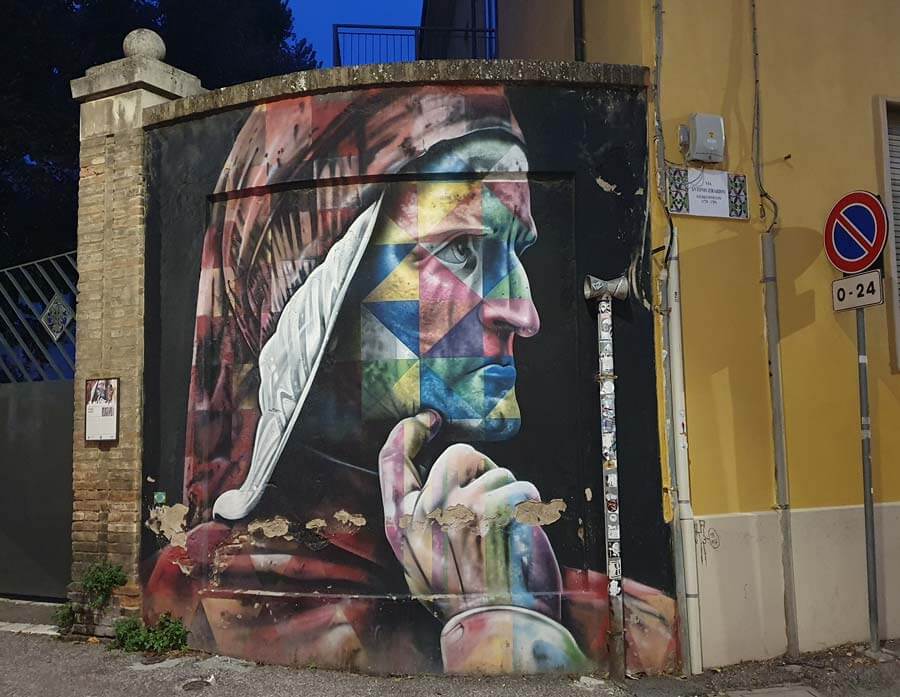
Ravenna travel, transport and practicalities
Getting there and around
The best airport for visiting Ravenna is Bologna Airport.International and efficient, though not that large, Bologna generally has direct connections with UK airports operated by several different airlines. As described above, the airport is connected to Bologna Centrale station by a monorail shuttle (quick and scenic, but expensive). From Bologna Centrale there are cheap regional trains to Ravenna. The total journey time from the airport to Ravenna station takes between one and half and two and a half hours by public transport, depending on timetables.
The nearest airport to Ravenna is actually at Forlì (sometimes called Bologna Forlì), but at the time of writing there are very few international flights using this airport. Rimini airport, a bus and train ride away, has summer flights from the UK and is another possible gateway to Ravenna, especially if you are planning a beach-and-culture touring holiday.
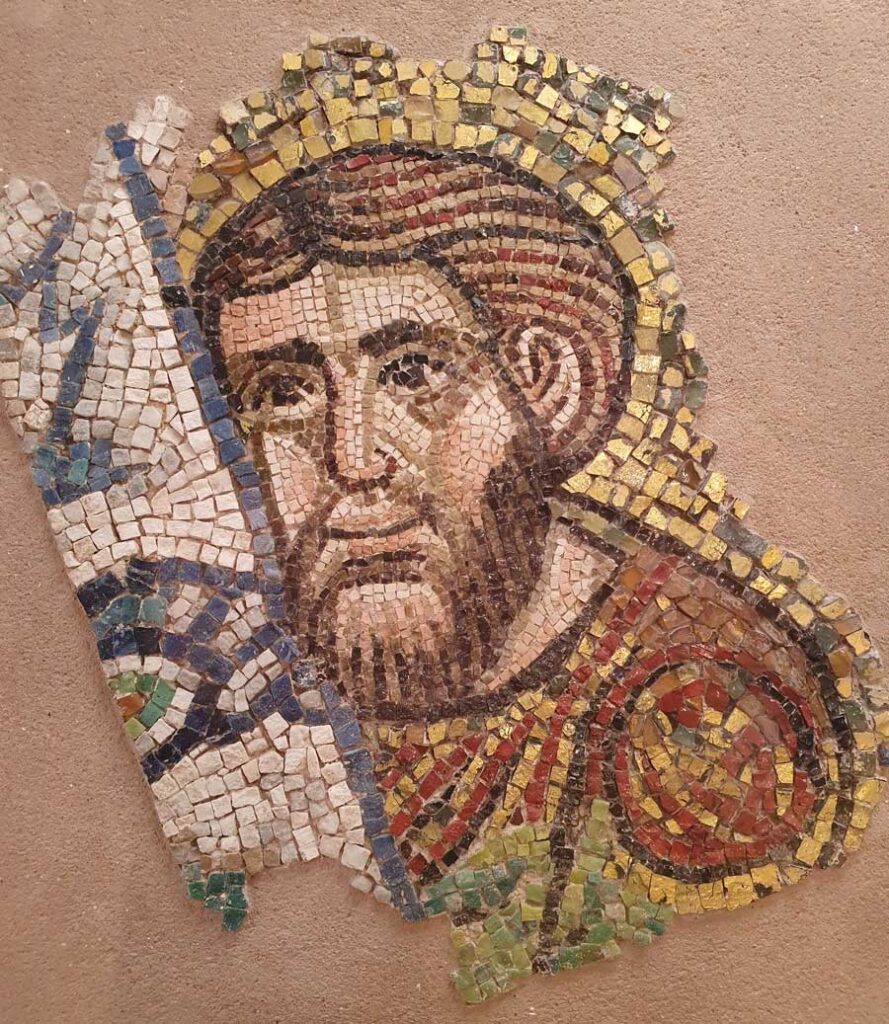
Trains – Ravenna is on a rather slow railway line from Bologna (an hour and twenty minutes away by regional train), which has good connections with the Italian rail network. As your train approaches Ravenna from the Bologna direction you can see the Mausoleum of Theodoric on the left: a white cylindrical tomb.Ravenna is also connected by regional trains with Rimini and other coastal resorts.
If you are arriving in Ravenna by train, you can walk into the historic centre on foot in about ten minutes. Simply cross the road outside the railway station and head straight ahead along Viale Farini and then Via Diaz until you reach Piazza del Popolo. There are also buses which connect the station with the centre and other parts of town.
Buses in and around Ravenna are mostly run by Start Romagna. They currently accept tickets bought at ticket offices and also contactless payments (one credit card per traveller), but check the latest options as the technology changes fast. I had started a week of travel in Rimini and bought a combined rail and Start Romagna pass which included transport on regional trains in this area and all the local Start Romagna buses. I found Google Maps was useful and accurate on the bus route and times in Ravenna.
Local people travel around by bicycle, bumping through the cobbled pedestrianised streets and using cycle lanes heading further afield. Some of the local hotels and B&Bs offer free bike rental, and there are a number of bike rental businesses. Velostazione (Ve.Ra) just outside the railway station on the left – has bicycles for hire and also offers a left-luggage service to travellers.
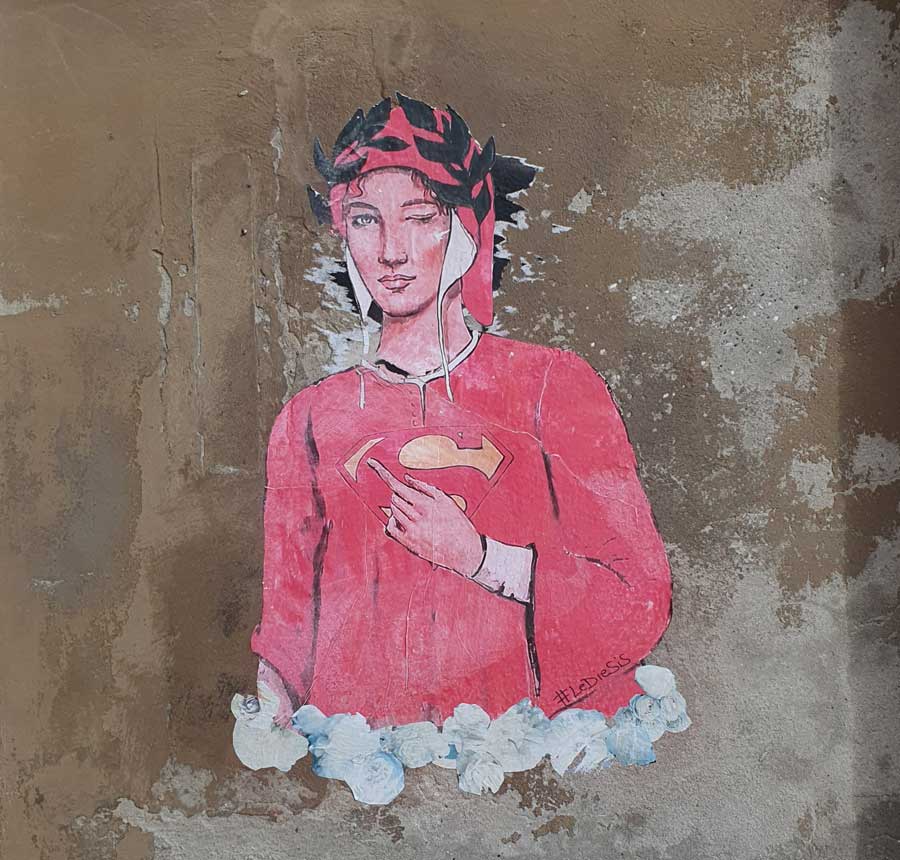
How long to stay in Ravenna?
I’ve touched on this question in my bullet-point planning list at the top of this page. I’ve visited Ravenna twice and each time I stayed for two nights. Although most of the sights have obligingly long and standardised opening hours, it is still quite a trek fitting them all in. And while the mosaic sites are open daily, it’s important to remember that most museums in Italy, including Ravenna, are closed on Mondays.
If you want to see all the important buildings and mosaics, I would recommend spending at least a day and a night in Ravenna and doing some careful planning. On both occasions I actually ended up writing a list and ticking off sights as I visited them. It was fun but quite rushed.
Two full days would allow for a more leisurely experience, with pauses over a glass of wine or coffee to reflect on the mosaics you’ve just seen, rather than risk them blurring into one another in your memory. Even with two days, though, you may find there is a museum or a sight you haven’t yet fitted in. With the time and budget – luckily Ravenna is not an expensive destination – I think it would be ideal to stay for around five nights, taking one or two day trips into the surrounding area.
Packing and planning
Once you’re in Ravenna, the tourist information office in Piazza San Francesco makes a good place to start your itinerary. It stocks maps and useful information including lists of the sights, as well as providing staff to help with advice and answer.
Ravenna used to be a lagoon city which contained canals and waterways, now filled in. Long ago malaria was rife, and in the Middle Ages Dante died after a marshy journey from Venice. In more recent years there have been brief outbreaks of mosquito-carried illness; it’s worth packing your insect repellent in summer and autumn.
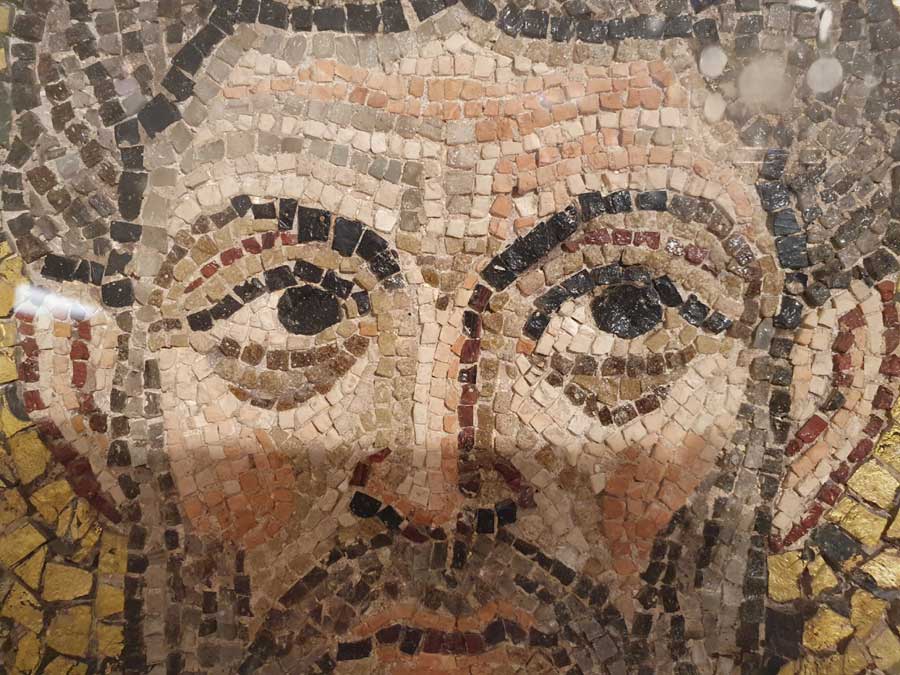
How touristy is Ravenna?
I wouldn’t want to give the impression that Ravenna is tourist-free. The main attractions feature on tour groups’ itineraries. These groups, including school parties, tend to be ferried around by coaches, though so they don’t flood the town. It’s as well to be prepared for occasional crowds at the most important churches, though. You may have to wait for timed entry to the tiny Mausoleum of Galla Placidia, and I saw influencers stripping off layers to twirl in San Vitale (it’s a church, don’t emulate them, and do stay respectfully dressed!). There are more cruise ships at the port nearby these days, and some passengers will spend a day exploring the town.
The best way to avoid groups is to visit sights first thing in the morning, in the later afternoon, or while tour groups are at lunch. I’ve found that the larger groups usually visit just one or two of the biggest sites, so the smaller attractions are much quieter and sometimes I’ve been the only visitor.
Cruises and the port
Ravenna has been increasingly featured on cruises around Italy and the Adriatic, especially since Venice’s restrictions on cruises were introduced. Ravenna’s cruise port, which currently has fairly minimal facilities, is a few miles from town, on the sea across a wide channel from Marina di Ravenna (the town’s seaside ‘suburb’; a ferry crosses the channel between port and suburb). There are infrequent local buses running from Ravenna to stops nearby, but the best option for passengers would be to take an organised cruise shuttle bus between the port and central Ravenna.
> Cruises around Italy
Around Ravenna
Bologna is a big city with lots to see, and it is in easy reach of Ravenna by train. There are also train services to the Renaissance city of Ferrara, which combines very well with Ravenna as part of a cultural holiday or tour.
Several smaller towns and villages in the vicinity offer the chance for a lower-key day trip with one or two sights of interest and time for a long lunch. This is fairly straightforward using public transport. Faenza, 30 minutes away by train, is a charming town famous for its ceramics, with a renowned museum of ceramics – if you have time, travel beyond it to Brisighella, one of the loveliest villages in Italy.
The Adriatic coast of Emilia-Romagna is lined with seaside resorts, and spending an afternoon by the sea or planning a two-centre holiday to appreciate the variety of the region would add an extra dimension to a stay in Ravenna. The most famous beach resort is Rimini, but there are plenty more including Ravenna’s own seaside suburb at Marina di Ravenna. I particularly like Cesenatico, a resort between Ravenna and Rimini on the railway line: you’ll find a picturesque old town along a wide boat-lined canal and a modern seaside district with a long sandy beach.
If you are cycling or have a car you could explore more of the local area including the Pineta di Classe. Car drivers can also head northwards to the nature reserves around the Po delta. Comacchio, easier to reach by car than public transport, offers an atmospheric lagoon environment and a historic canal town.
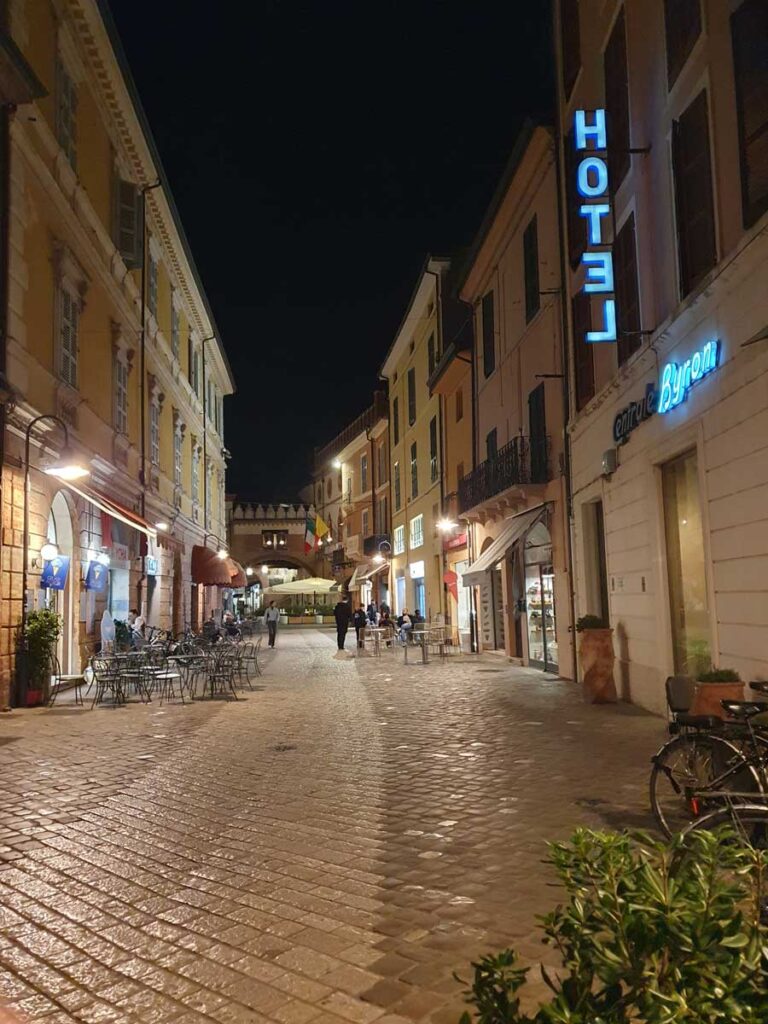
Read about Ravenna
For an overview of the fascinating history of Ravenna, the best read is probably Ravenna: Capital of Empire, Crucible of Europe by Judith Herrin (Amazon UK affiliate link). The book can be slightly hard work at times (there’s a lot of detail to get through), and I wasn’t keen on the double standards on show in the judging of women from Ravenna’s ancient past, but overall it’s a very helpful preparatory read to give a deeper understanding of the city.
Emilia-Romagna destinations
